To keep Blue Jays away from your feeders, use cage-style or weight-activated feeders that exclude larger birds while allowing smaller species access. Choose bird seeds Blue Jays dislike such as nyjer thistle, safflower, or small millet. Create a separate Blue Jay feeding station with peanuts and sunflower seeds on the opposite side of your yard as a distraction. Timing matters too—refill feeders when smaller birds are most active. These strategies will help balance your backyard bird community.
Understanding Blue Jay Behavior at Feeders
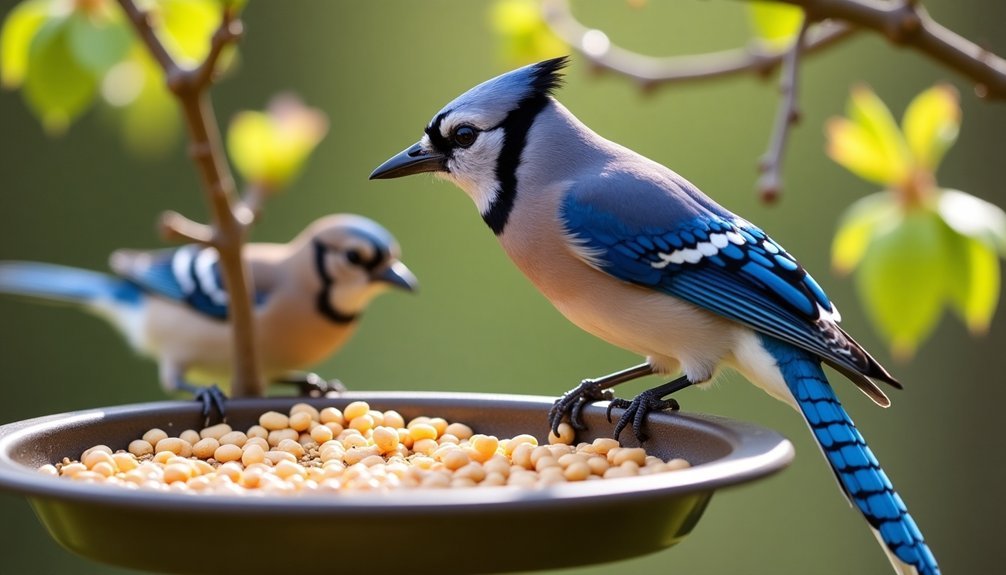
When observing Blue Jays at your feeders, you'll notice their predictable yet adaptable behavior. They typically visit three times daily: shortly after sunrise, at midday, and in mid-late afternoon.
During poor weather, however, they'll often remain at feeders all day. These intelligent birds can recognize human faces and may respond differently to familiar people who regularly fill their feeders.
When storms arrive, Blue Jays abandon their usual schedule, seeking shelter and sustenance at your feeders throughout the day.
Blue Jays strongly prefer shelled peanuts and sunflower seeds, which they'll cache before bad weather. Despite their reputation as bullies, they rarely attack other birds directly. Smaller species may leave due to the jay's size rather than actual aggression.
Weather greatly influences their feeding patterns—cold, snow, or rain increases feeder visits. When natural food sources like acorns are abundant, you'll see them less frequently.
They're intelligent birds that prefer clean, well-stocked feeders and may avoid ones that are poorly maintained.
Why Blue Jays Dominate Your Backyard Habitat
Blue jays control your backyard through aggressive territorial displays that scare smaller birds from your feeders.
Their imposing size—twice as large as chickadees—gives them a natural advantage when competing for food resources.
You'll often see them swooping in to claim entire feeding areas, rapidly filling their expandable throat pouches with seeds to hoard elsewhere. This caching behavior allows them to store acorns and nuts for later consumption, reflecting their omnivorous diet that's 75% vegetable matter.
Territorial Behavior Patterns
Although many backyard birds display territorial tendencies, the Blue Jay's dominance strategy is particularly effective and visible. You'll notice their aggression through distinct crest positions—the higher the crest, the more aggressive the bird.
These clever birds employ various tactics to control your feeders. They'll chase smaller birds away through direct confrontation, while using mimicry of hawk calls to temporarily clear feeding areas. Their loud, conspicuous presence serves as territorial marking, especially during feeding times. This territorial behavior becomes even more pronounced when Blue Jays form winter foraging flocks that can exceed 100 birds visiting a single location.
Blue Jays organize themselves in social hierarchies, forming larger flocks in winter that break into smaller groups during breeding season.
While they're generally dominant at feeders, they may face resistance from larger woodpeckers or determined sparrows. Despite their intimidating reputation, they're actually less confrontational than some other backyard species.
Intimidation Through Size
At first glance, you might underestimate a Blue Jay's physical presence until one lands confidently at your feeder. Despite not being the largest backyard visitor, Blue Jays command respect through their bold demeanor and aggressive tactics.
These birds punch above their weight class in the avian hierarchy. While they'll yield to American Crows and sometimes woodpeckers, they easily dominate smaller songbirds like chickadees, titmice, and nuthatches. Studies have shown that providing diverse food types can significantly reduce this bullying behavior at your feeders.
Even larger Mourning Doves often retreat when Blue Jays arrive.
What Blue Jays lack in absolute size, they compensate for with intelligence, speed, and vocalizations. They'll swoop in quickly, make noise, and chase competitors away.
Their high energy and adaptability help them maintain dominance, creating an intimidation factor that exceeds their actual physical dimensions.
Resource Hoarding Tactics
When it comes to backyard dominance, resource hoarding stands as one of the blue jay's most effective strategies. These clever birds can collect up to 107 acorns in a single day, distributing them across multiple hidden caches.
You're not just witnessing random feeding—you're seeing calculated stockpiling.
Blue jays excel at deception, often pretending to hide food in one location before moving it elsewhere to fool potential thieves. Their exceptional spatial memory allows them to retrieve these stores during scarce periods, giving them a significant survival advantage over other backyard visitors. This approach mirrors fantasy sports strategists who create market advantage by controlling scarce positions like catchers.
This hoarding behavior explains why your feeders empty so quickly. When a blue jay appears, it's not just eating—it's systematically gathering resources for later use, effectively reducing food availability for other birds you might prefer to attract.
Best Feeder Designs That Exclude Larger Birds
You'll find that cage-style exclusion feeders create a physical barrier that allows smaller birds in while keeping blue jays out.
Weight-activated feeder mechanisms automatically close when heavier birds like blue jays try to land, effectively limiting their access to seed.
Small perch designs discourage larger birds who can't comfortably balance on tiny platforms, giving your smaller feathered friends a fighting chance at the buffet. The innovative Medusa Feeder Defender uses dangling chains as protection while maintaining excellent visibility of your feathered visitors.
Cage-Style Exclusion Feeders
Three ingenious designs make cage-style feeders the most effective solution for keeping blue jays away from your bird feeders. Tube feeders surrounded by protective cages prevent large birds from accessing the seed while allowing smaller birds to fly through the mesh.
On-Guard protectors can be added to existing feeders, instantly converting them into exclusion systems. Suet and peanut feeders with built-in guards complete the trifecta of effective options.
These caged designs offer multiple benefits beyond blue jay exclusion. You'll notice reduced seed spillage, cleaner feeding areas, and protection from squirrels and other mammals. The Audubon Squirrel-Resistant Caged Tube Bird Feeder features a substantial green cage that keeps larger birds and squirrels at bay.
The mesh also serves as additional perching space for waiting birds. For best results, pair your caged feeder with a separate feeding station for blue jays to maintain ecosystem balance.
Weight-Activated Feeder Mechanisms
Weight-activated feeders represent a technological marvel in the world of bird feeding. These innovative solutions automatically close feeding ports when a creature exceeding your preset weight threshold attempts to feed. Blue jays, being heavier than songbirds like finches and chickadees, trigger the mechanism and are denied access. The SS200 model utilizes this exact technology with its squirrel-proof design that works equally well for excluding larger bird species.
| Feature | Benefit |
|---|---|
| Adjustable settings | Customize to allow specific bird sizes |
| Automatic closure | No manual intervention needed |
| Multiple ports | Serves several small birds simultaneously |
| Clear windows | Monitor seed levels easily |
| Durable materials | Withstands weather and persistent visitors |
You'll appreciate the peace of mind knowing your seed is protected for smaller birds. These feeders typically hang 5-6 feet above ground and require only basic maintenance with soap and water—perfect for year-round use with various seed types.
Small Perch Designs
Small perch designs represent one of the most effective strategies for excluding blue jays from your bird feeders.
By installing tube feeders with tiny perches, you'll make it nearly impossible for larger birds to land and feed comfortably. Fine mesh feeders work similarly, providing access only to smaller species like finches.
Consider upside-down feeders that require birds to hang inverted while feeding—a position blue jays find difficult to maintain.
For a DIY approach, try using small cracked plastic bottles or wooden sticks inserted into log holes as minimal perches. A 1/2 diameter dowel cut to a shorter length than standard perches will accommodate small songbirds while deterring larger species.
When selecting feeders, look for those with small entrances, tight perch spacing, and modified roof designs.
Hanging orientation matters too—position entrances facing downward to further challenge larger birds while accommodating agile smaller visitors.
Seed Selection Strategies to Deter Blue Jays
Strategic seed selection stands at the forefront of deterring blue jays from monopolizing your bird feeders. Fill your main feeders with nyjer thistle, safflower, and small millet seeds—options blue jays typically avoid. These smaller seeds attract finches and other songbirds while naturally discouraging jay visits.
Create a blue jay station away from your primary feeders by offering their favorites: peanuts, acorns, and black oil sunflower seeds. This redirection tactic satisfies their appetites elsewhere.
Try blending preferred and non-preferred seeds to make feeders less appealing to these large birds. Many experienced birders find this approach unnecessary since blue jays are native birds that contribute positively to the local ecosystem.
Adjust your seed offerings seasonally, monitoring which mixes work best. Supporting native plants that provide natural food sources can also reduce blue jays' dependence on your feeders while maintaining a diverse backyard bird population.
Creating Separate Feeding Stations for Different Species
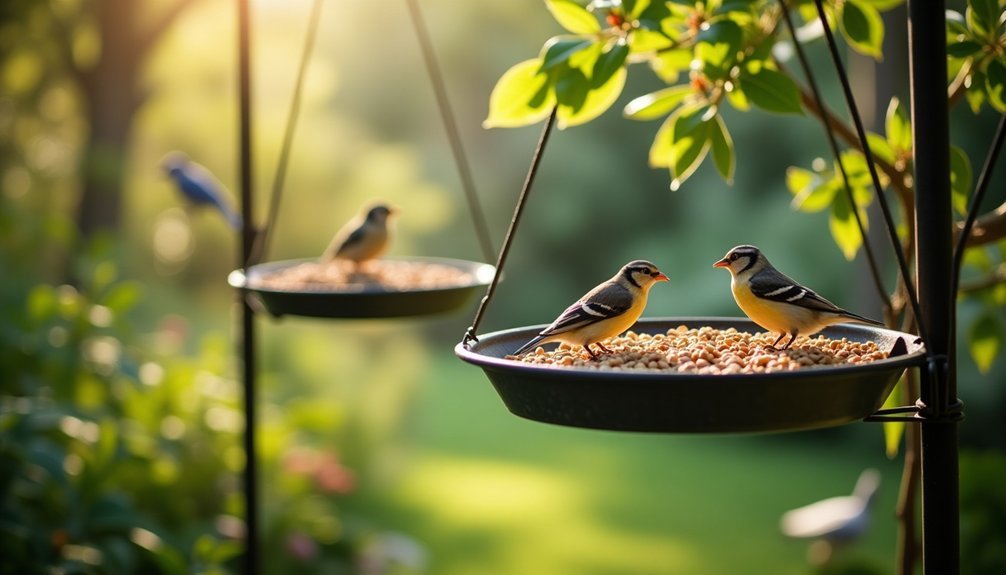
Establishing multiple feeding zones in your yard represents one of the most effective approaches to managing blue jay behavior while still welcoming diverse bird species. By strategically placing different feeder types throughout your space, you'll create natural divisions that cater to specific birds' preferences. Cover from trees makes birds feel safer when visiting feeders, significantly increasing their likelihood to return.
| Species | Preferred Feeder | Ideal Location | Food Type |
|---|---|---|---|
| Songbirds | Tube feeders | Near shrubs | Sunflower seeds |
| Finches | Nyjer feeders | Open areas | Nyjer/thistle |
| Ground-feeders | Platform feeders | Under trees | Mixed seed |
| Blue jays | Separate platform | Away from others | Peanuts/corn |
Position blue jay stations farther from your main feeding area, perhaps near denser tree cover. This separation creates a designated space for jays while protecting smaller birds at your primary feeders. You'll enjoy watching all species while maintaining harmony in your backyard habitat.
The Magic of Caged and Weight-Sensitive Feeders
When standard feeders fail to deter persistent blue jays, specialized equipment offers an elegant solution to the problem.
Caged feeders create a physical barrier with openings sized perfectly for smaller birds while blocking larger blue jays. These cost-effective, durable options provide a peaceful dining experience for your favorite songbirds. Offering nyjer thistle seed is another effective strategy since it's less appealing to blue jays but highly attractive to finches.
Weight-sensitive feeders offer a more sophisticated approach, closing access when heavier birds land. You'll appreciate their unobstructed view and lower maintenance requirements compared to caged models. Many allow you to adjust the weight threshold to accommodate your desired bird visitors.
- Watch with delight as chickadees and finches dine peacefully without blue jay bullies
- Feel proud knowing you've created a fair feeding environment for vulnerable species
- Enjoy the satisfaction of outsmarting those clever but greedy blue jays
Strategic Placement to Minimize Blue Jay Access
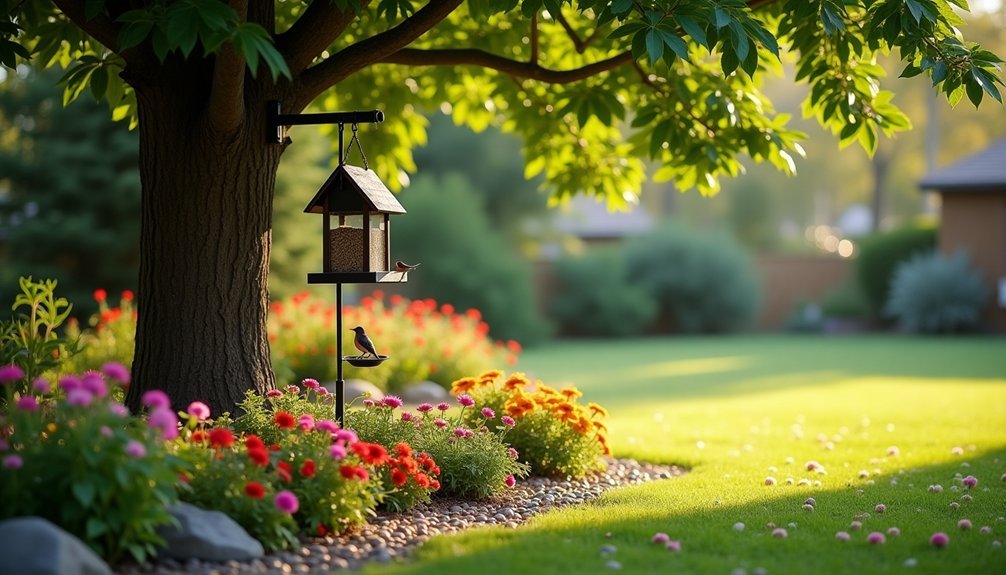
You'll find that small perching areas on your feeders can effectively limit Blue Jays, which require more space than smaller birds to comfortably land and feed.
Keep feeders with tiny perches at least 15 feet away from platform feeders to create separate feeding zones for different bird species.
Spacing your feeders strategically creates a natural partitioning system where Blue Jays gravitate toward the accommodations designed for their size while leaving the less accessible options for your finches and chickadees.
Consider installing feeders at a height of 5 to 7 feet from the ground to maintain accessibility for smaller birds while creating an optimal viewing experience.
Perching Area Designs
Strategic perching area designs can greatly limit blue jay access to your feeders while still accommodating smaller birds.
Weight-sensitive perches are particularly effective when adjusted below a blue jay's body weight, allowing chickadees and finches to feed while excluding their larger competitors.
Consider feeders with narrow perching surfaces, as blue jays strongly prefer wider landing areas and may avoid these altogether. Unlike smaller birds, blue jays require stable feeders that don't swing or sway while they eat.
- Create a peaceful backyard sanctuary where your favorite tiny songbirds can dine without intimidation from boisterous blue jays
- Experience the joy of watching small birds return confidently to your feeders without being bullied away
- Save money on birdseed that won't be devoured by hungry, opportunistic jays
For maximum effectiveness, combine these perching strategies with cage-enclosed feeding areas that physically prevent larger birds from reaching the seed.
Distance Between Feeders
Proper spacing between bird feeders creates one of your most powerful defenses against blue jay domination. Place feeders at least 15-20 feet apart, ensuring they're not within the same line of sight. This separation reduces the likelihood that blue jays will monopolize all your feeding stations.
Strategic placement near trees or shrubs gives smaller birds escape routes while making specific feeders less appealing to jays. Consider using safflower or Nyjer seeds in feeders you want to protect – blue jays typically avoid these options. Blue jays are known to prefer peanuts in shell and will often shake them to determine if they're full.
For maximum effectiveness, establish a "blue jay station" with peanuts or sunflower seeds far from your other feeders. This dedicated area diverts their attention and satisfies their appetite elsewhere.
Weighted or caged feeders will further restrict jay access while allowing smaller species to feed undisturbed.
Timing Your Feeder Refills to Favor Smaller Birds
While blue jays tend to dominate feeding areas with their aggressive behavior, carefully timing your feeder refills can create opportunities for smaller birds to access food without competition.
Consider allowing your feeders to become partially empty before refilling, as blue jays prefer abundant food sources and may seek meals elsewhere when supplies dwindle. In many-port tube feeders, allowing seed levels to decrease can limit access to upper ports while encouraging visits from diverse bird species.
Refill your feeders during early morning hours when smaller birds are more active, establishing a routine that benefits these species.
During winter, maintain consistent food availability for smaller birds that need regular energy sources, but avoid overfilling which attracts jays.
- Watch your smaller feathered friends dart in joyfully when blue jays aren't bullying them at the feeder
- Experience the satisfaction of outsmarting aggressive birds with simple timing adjustments
- Enjoy greater diversity at your feeders as timid species gain confidence
Alternative Food Sources That Blue Jays Ignore
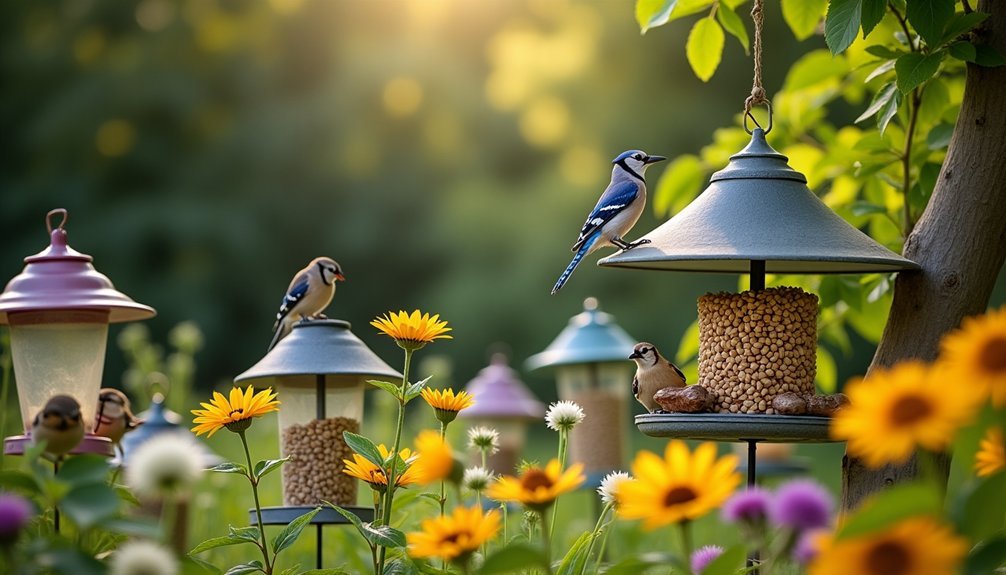
Selecting the right seed types can dramatically reduce blue jay competition at your feeders while still attracting a diverse array of smaller songbirds. Safflower seeds and Nyjer thistle are particularly effective deterrents, as blue jays actively avoid these options while finches, chickadees, and titmice readily consume them.
Try using purified birdseed mixes that lack peanuts and sunflower seeds—blue jays' favorites—but still appeal to smaller birds. Small-seeded mixes are another excellent choice, as blue jays prefer larger, high-fat foods. Blue jays typically seek out acorns and hazelnuts as their primary natural food sources during winter months.
Consider using specialized tube feeders with small feeding ports that physically exclude larger birds while allowing access to smaller species.
For best results, position these alternative food sources in bushy areas where smaller birds feel safe but blue jays find navigation difficult.
Landscaping Techniques to Protect Small Bird Feeding Areas
Creating a bird-friendly landscape around your feeders can dramatically reduce blue jay interference. Install paving stones or concrete slabs beneath feeders to prevent seed sprouting and make cleanup effortless.
This hard surface deters blue jays who prefer natural ground for foraging, while smaller birds can still access fallen seeds. Rock gardens provide an excellent low-maintenance solution that discourages larger birds while still being accessible to smaller species.
Strategic plant selection creates natural barriers that smaller birds can navigate but blue jays find challenging. Consider fairy roses, creeping rosemary, or black-eyed Susans that thrive despite seed debris.
- Transform your backyard into a sanctuary where chickadees and finches feel safe from bullying
- Watch with delight as colorful songbirds return day after day to your thoughtfully designed space
- Experience the satisfaction of outsmarting persistent blue jays without harming them
Distraction Techniques: Dedicated Blue Jay Feeding Zones
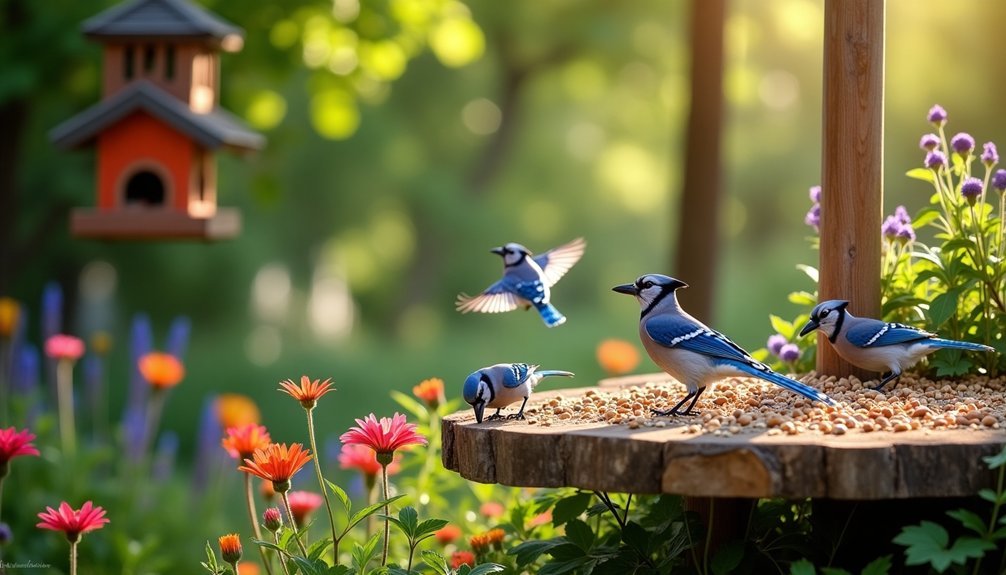
One effective strategy for managing blue jay behavior is establishing dedicated feeding zones that redirect these bold birds away from your main feeders.
Place these specialized areas on the opposite side of your house, creating visual barriers between different feeding stations.
Stock blue jay zones with their favorites: peanuts, acorns, black-oil sunflower seeds, and corn. Their strong bills enable them to easily crack these harder food items while keeping them occupied away from smaller birds.
Use sturdy tray or wreath feeders that accommodate their size and feeding style. Position these feeders near shrubs or trees, away from human activity and nesting sites.
Blue jays typically visit feeders during three main feeding periods throughout the day.
Monitoring and Adapting Your Blue Jay Management Plan
Successfully managing blue jay activity requires ongoing observation and flexibility. Watch how blue jays interact with your feeders—noting which foods they prefer and when they visit most frequently.
Adjust your strategy seasonally, offering more suet and peanuts in winter when blue jays need extra calories. If they're dominating your feeding stations, try repositioning feeders near shrubs or trees to provide natural cover for smaller birds. Blue jays are highly intelligent birds that will quickly figure out your feeding strategy, so be prepared to modify your approach accordingly.
Adapt feeding techniques with the seasons, placing feeders strategically to maintain balance between blue jays and smaller visitors.
- Feel the satisfaction of creating a balanced backyard ecosystem where all birds can thrive
- Experience the joy of watching diverse bird species return as your management plan succeeds
- Enjoy the pride of solving the blue jay puzzle through your own observations and adaptations
Remember to maintain feeders regularly and diversify food options to keep your management plan effective.
Frequently Asked Questions
Do Blue Jays Remember Humans Who Have Interacted With Them?
Yes, you'll find that Blue Jays likely remember you if you've interacted with them. They possess advanced memory capabilities similar to other corvids and can recognize individuals who've been part of their environment.
Will Ultrasonic Deterrents Keep Blue Jays Away Without Affecting Smaller Birds?
No, ultrasonic deterrents won't selectively repel Blue Jays. Most birds can't hear frequencies above 20,000 Hz, making these devices ineffective. You'll have better results using weighted feeders or offering separate peanut feeders instead.
Can Blue Jays Be Legally Deterred in Protected Wildlife Areas?
In protected wildlife areas, you can't legally deter Blue Jays without permits. They're protected under the Migratory Bird Treaty Act. You'll need to consult local wildlife authorities for specific legal deterrent options in these zones.
How Do Seasonal Migrations Affect Blue Jay Feeding Patterns?
During migrations (fall and spring), you'll notice Blue Jays foraging in flocks, focusing on natural foods rather than feeders. They're following acorn and beechnut availability, which directly impacts when and where they'll feed.
Do Predator Decoys Effectively Scare Away Blue Jays Long-Term?
Predator decoys initially scare blue jays but aren't effective long-term. These intelligent birds quickly recognize static decoys as harmless. You'll need to frequently move your decoys or combine them with other deterrent methods.
In Summary
You don't need to banish blue jays completely—just outsmart them. With the right feeder designs, seed selection, and strategic placement, you'll create a balanced backyard ecosystem. Remember, consistency is key. Monitor which techniques work best in your space and adjust accordingly. You're not just protecting smaller birds; you're creating a more diverse, enjoyable bird watching experience that accommodates all your feathered visitors.

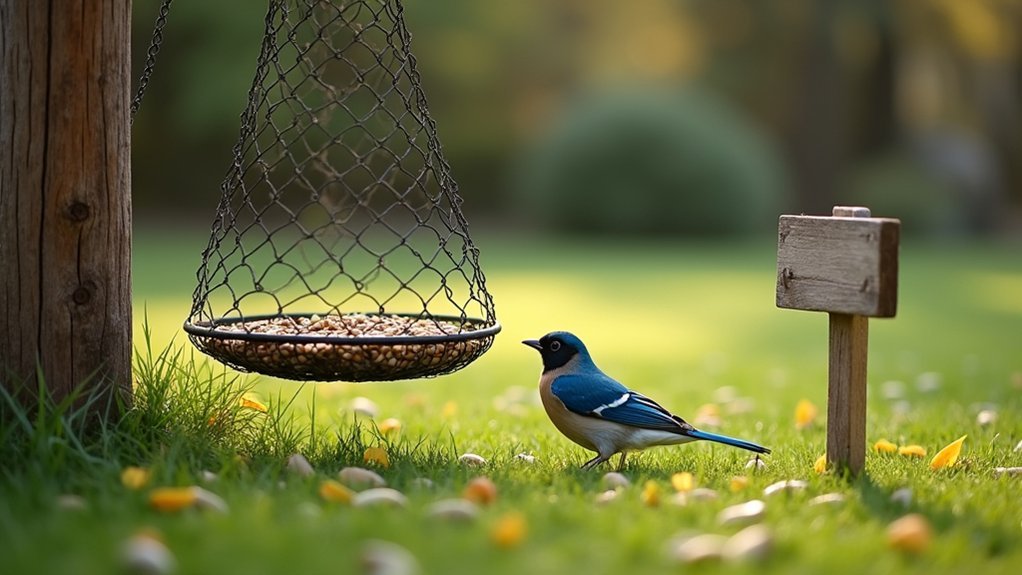



Leave a Reply